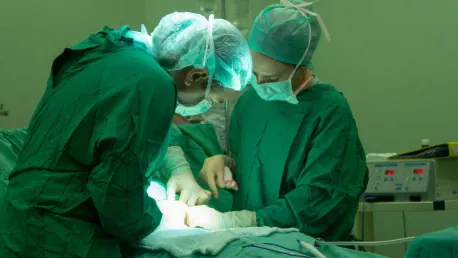The advent of remote patient monitoring (RPM) is transforming post-surgical recovery in profound ways. In the United States, the need for effective post-surgical care is critical, evidenced by a study indicating that over 11% of Americans underwent surgery within the past year. Given the high incidence of post-operative complications, such as pain and infections, there is an urgent need for meticulous and continuous monitoring. Traditionally, this has been managed through extended hospital stays or frequent clinic visits.
Transforming Traditional Recovery Methods
The Challenges of Conventional Care
Traditionally, post-surgical recovery required patients to stay in hospitals for prolonged periods or make frequent visits to healthcare facilities. This method is resource-intensive and increases risks such as hospital-acquired infections. In a hospital setting, patients are exposed to a myriad of microorganisms, making them vulnerable to infections that could complicate recovery. Furthermore, the high costs associated with prolonged hospital stays put a strain on both patients and healthcare resources. The need for frequent trips to the clinic for follow-ups also adds to the financial and logistical burdens on patients, who may already be grappling with post-surgical pain and mobility issues.
The Shift to Technology
The adoption of healthcare technology has significantly altered this landscape, leading to a shift towards remote patient monitoring systems. These systems enable patients to recover safely at home while still being closely observed by medical professionals. Patients can now take advantage of modern advancements in technology to monitor their health remotely, easing the strain on healthcare facilities and providing a safer environment for recovery. RPM allows healthcare providers to keep a vigilant eye on their patients’ progress, preventing unnecessary trips to the hospital and improving the overall patient experience. This shift not only addresses the limitations of conventional care but also paves the way for more personalized and patient-centered recovery protocols.
Advantages of Remote Patient Monitoring
Real-Time Health Tracking
RPM systems are designed to track various vital signs in real-time, including heart rate, oxygen levels, blood pressure, and temperature. These systems are equipped with sophisticated sensors that continuously record and transmit data, providing a comprehensive snapshot of a patient’s recovery process. The real-time tracking capability of RPM systems enables healthcare providers to keep a constant watch on their patients’ health, even from a distance. This continuous monitoring is crucial in detecting potential complications early, thereby preventing them from escalating into more serious conditions. By having access to real-time data, healthcare providers can make timely and informed decisions, adjusting treatment plans as necessary to ensure optimal recovery outcomes for their patients.
Prompt Interventions and Reduced Readmissions
Given the real-time data collected, healthcare providers can quickly identify abnormalities and intervene, reducing the chances of complications, hospital readmissions, and emergency room visits. When a potential issue is detected, medical professionals can respond promptly, whether it’s by adjusting medication dosages, recommending lifestyle changes, or scheduling immediate follow-up consultations. This proactive approach not only mitigates risks but also enhances the overall quality of care. Moreover, reducing hospital readmissions and emergency room visits alleviates the burden on healthcare systems, allowing resources to be allocated more efficiently. Patients benefit from a smoother recovery process, experiencing fewer disruptions and feeling more confident in their journey towards regaining health.
Enhanced At-Home Care
Comprehensive RPM Features
Comparing different RPM systems, it becomes evident that each comes with features such as real-time vitals tracking, automated alerts, and online communication tools. These features are designed to provide comprehensive support for patients recovering at home, ensuring that they receive timely medical attention when needed. Automated alerts notify healthcare providers of any irregularities in a patient’s vital signs, prompting immediate action. Patients also have access to online communication platforms that facilitate seamless interaction with their healthcare teams. Selecting the right software is crucial for effective and efficient use by both healthcare professionals and patients. An intuitive and user-friendly interface ensures that patients can easily navigate the system, while healthcare providers can efficiently monitor and manage multiple patients without being overwhelmed.
Improved Communication
Another advantage of RPM is the enhanced communication between patients and healthcare providers. Many RPM systems include interactive components such as apps or video consultations, allowing patients to receive guidance on various post-operative care aspects without the need for frequent visits. This improved communication fosters a stronger patient-provider relationship, empowering patients to take an active role in their recovery process. Through video consultations, patients can discuss their symptoms, ask questions, and receive personalized advice from their healthcare providers in real-time. In turn, healthcare providers can offer tailored guidance, addressing any concerns promptly and ensuring that patients adhere to their recovery protocols. Such robust communication channels contribute to a more collaborative and supportive recovery environment.
Empowering Patients and Caregivers
Continuous Support
Recovering at home can be daunting, but continuous monitoring and feedback reassure patients by keeping them connected to their healthcare teams. This support enhances adherence to recovery protocols, speeding up and ensuring a more complete recovery. Patients are less likely to experience setbacks when they have access to round-the-clock monitoring and real-time feedback, enabling them to make informed decisions about their health. The psychological benefit of knowing that medical professionals are closely watching over their recovery cannot be overstated. It instills a sense of security and confidence in patients, encouraging them to follow prescribed protocols diligently and actively participate in their rehabilitation.
Caregiver Guidance
Caregivers also benefit from RPM systems by receiving reliable health data and expert guidance, enabling them to assist their loved ones more effectively. With access to accurate and up-to-date health information, caregivers can make better-informed decisions regarding the care they provide. They can promptly respond to any changes in the patient’s condition, provide timely interventions, and seek professional advice when necessary. RPM systems also offer educational resources and support tools for caregivers, helping them navigate the complexities of post-surgical care. Equipped with the right knowledge and resources, caregivers can play a pivotal role in the patient’s recovery journey, contributing to better health outcomes and overall well-being.
Patient Compliance and Outcomes
Supporting ERAS Protocols
Remote patient monitoring greatly aids adherence to Enhanced Recovery After Surgery (ERAS) protocols. These protocols are designed to improve recovery outcomes by promoting evidence-based practices and optimizing perioperative care. Studies indicate that ERAS-compliant patients supported by RPM are less likely to experience complications, achieving better recovery outcomes. The continuous monitoring offered by RPM systems ensures that patients adhere to the ERAS protocols, such as maintaining optimal nutrition, staying hydrated, and engaging in appropriate levels of physical activity. When deviations from these protocols are detected, healthcare providers can quickly intervene, providing tailored guidance to get patients back on track. This proactive approach helps minimize risks and enhances the overall efficacy of ERAS protocols.
Optimal Recovery
Approximately 79% of patients following ERAS protocols with RPM support achieved optimal recovery, compared to 62% of those who did not, underlining the importance of RPM in post-surgical care. The integration of RPM in post-surgical recovery plans facilitates better patient compliance, which is crucial for achieving desired health outcomes. The data underscores the significant impact that continuous monitoring and adherence to recovery protocols can have on patient outcomes. By leveraging RPM technology, healthcare providers can implement more effective recovery strategies, ultimately leading to improved patient satisfaction and a higher quality of life post-surgery.
Addressing Common Concerns
Types of Surgeries and Insurance Coverage
Surgeries requiring long-term follow-ups, such as orthopedic, cardiovascular, and abdominal surgeries, benefit significantly from RPM. These types of surgeries often involve complex recovery processes that necessitate ongoing monitoring and support. RPM provides the continuous oversight needed to manage such intricate recoveries, reducing the risk of complications and promoting better outcomes. Medicare and many private insurers in the United States cover RPM for eligible patients, making it more accessible. Patients and their families can inquire about coverage options with their insurance providers to determine their eligibility for RPM services. By ensuring that patients have access to this valuable technology, healthcare systems can enhance the overall effectiveness of post-surgical care.
Data Security Compliance
Data security is paramount in RPM systems. Most use encrypted data transmission and comply with regulations like HIPAA or GDPR to protect patient information, ensuring data privacy. These measures are essential in safeguarding sensitive patient information from unauthorized access and potential breaches. Patients can inquire about the security protocols employed by their healthcare providers to ensure that their data is handled securely. Healthcare providers, on the other hand, must continuously update and reinforce their security measures to comply with regulatory requirements and maintain patient trust. As technology continues to evolve, the focus on robust data security practices will play a crucial role in the widespread adoption and success of RPM systems.
The Future of RPM
Technological Advancements
The future of RPM in post-surgical care looks promising, with advancements in artificial intelligence, predictive analytics, and machine learning. These cutting-edge technologies have the potential to further refine RPM systems, enabling healthcare providers to detect subtle signs of complications and respond preemptively. Predictive analytics can analyze large datasets to identify patterns and predict potential health issues before they manifest. Machine learning algorithms can continuously learn from patient data, improving the accuracy and reliability of the monitoring systems. As AI continues to evolve, the potential for enhanced RPM capabilities will grow, paving the way for more personalized and effective post-surgical care.
Shifting the Paradigm of Post-Surgical Care
The rise of remote patient monitoring (RPM) is significantly transforming post-surgical recovery. In the United States, the need for effective post-surgery care is critical. A study shows that over 11% of Americans underwent surgery in the past year, highlighting the importance of this care. The high rate of post-operative complications, such as pain and infections, necessitates careful and continuous monitoring. Traditionally, this monitoring has been handled through lengthy hospital stays or frequent visits to the clinic. RPM now offers a more efficient alternative by using technology to monitor patients’ conditions remotely. This approach allows healthcare providers to track recovery progress, manage pain, and quickly address any issues that arise, all without the patient needing to be physically present. By leveraging RPM, the healthcare system can reduce hospital readmissions, improve patient outcomes, and enhance the overall recovery experience, making it a pivotal innovation in post-surgical care.









